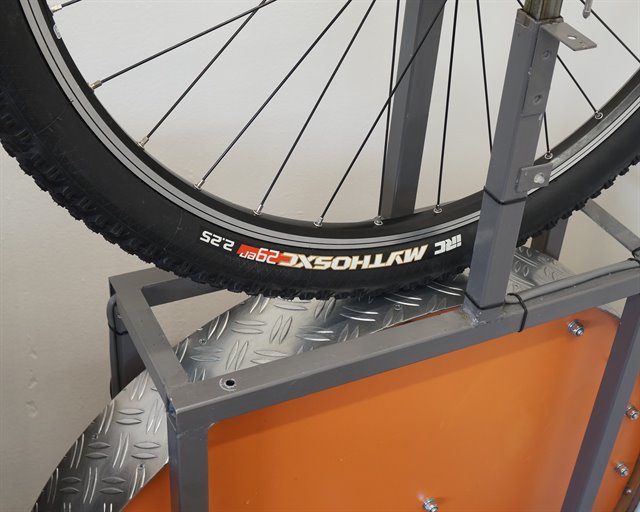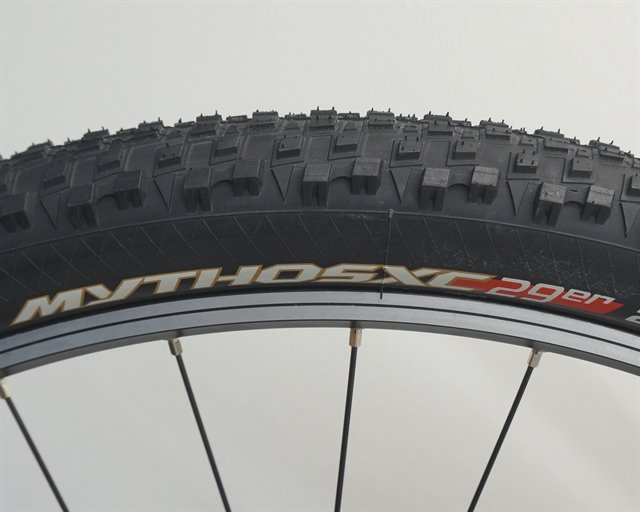Tire Lab Test: IRC Mythos XC 29x2.25
Contents and Test Summary
- Introduction
- Manufacturer Specifications
- Size, Weight, Thickness
- Rolling Resistance: 26.3 Watts
- Puncture Resistance: 25 Points
- Static Wet Grip: No Data
- Conclusion: 3.0 / 5 Recommended
- Comments
- IRC Mythos XC 2.25

I've chosen to test the Mythos XC because it's IRC's tire that comes closest to the Schwalbe Racing Ralph (read review) which I consider to be the gold standard XC MTB tire. The Mythos XC is available in both a regular and Tubeless Ready version. As the Tubeless Ready version is only available in the smaller 2.10 size, I've decided to test the regular version as that's available in both the 2.10 and 2.25 sizes.
The Mythos XC is the first tire from IRC that I'm testing. Testing new brands is always exciting as anything is possible in the puncture resistance and rolling resistance tests. When purely looking at the specifications, the Mythos doesn't seem anything special: 60 TPI casing, a relatively high weight of 710 grams, and an unspecified compound. Let's jump to the results to see if we've found an absolute gem or just a random performer as the specifications suggest.
Manufacturer Specifications
| Manufacturer Specs | |
|---|---|
| Brand | IRC |
| Model | Mythos XC |
| Year | 2017 |
| Supplied By | Bought in store |
| New or Used | New |
| Mileage | 0 km |
| Price Range | High |
| Buy At | |
| Manufacturer part number | |
| TPI | 60 |
| Compound | |
| Bead | Folding |
| ETRTO | 54-622 |
| Size Inch | 29" |
| Width Inch | 2.25 |
| Specified Weight | 710 grams |
| Max Air Pressure (psi) | 45 |
| Made In | Pro Data |
| Available Sizes |
26x1.95 26x2.10 26x2.25 27.5x2.10 29x2.10 29x2.25 |
IRC Mythos XC Test Results

Size, Weight, and Thickness Measurements
| Size, Weight, and Thickness Measurements | |
|---|---|
| Specified Weight | 710 grams |
| Measured Weight | 701 grams |
| Measured Width Carcass | 52 mm (un-round) |
| Measured Width Tread | 54 mm |
| Measured Height | Pro Data |
| Tire Circumference | Pro Data |
| Measured Knob Height Center | 2.2 mm |
| Measured Knob Height Edge | 4.0 mm |
| Measured Total Thickness Center (excluding knobs) | 2.2 mm |
| Measured Total Thickness Sidewall | Pro Data |
| All size measurements are taken at an air pressure of 35 psi / 2.4 bars on a 17.8 mm inner width rim. | |
The specified weight of the 29 x 2.25 Mythos XC is 710 grams; my sample is a bit lighter at 701 grams. The measured width on a 17C rim, at an air pressure of 35 psi / 2.4 bars is 54 mm wide. The maximum width of the casing is 52 mm which is on the small side for a 29 x 2.25 rated tire.
The tread pattern of the Mythos XC looks fast. The center knobs have a height of 2.2 mm which is less than the Racing Ralph (2.5 mm). The edge knobs have a height of 4.0 mm which is the same as the Racing Ralph. The sidewalls have a thickness of 0.65 mm which is right in the middle of the ultra thin sidewall tires that come in at 0.5 mm and the protected sidewall tires that come in closer to 0.8 mm.
Rolling Resistance Test Results
| Rolling Resistance Test Results | |
|---|---|
| Inner Tube | None (40 ml sealant) |
| Measured Width | 52 mm |
| Rolling Resistance Real tire width in mm: 47-50 = 42 psi/2.9 bar 51-55 = 38 psi/2.6 bar 56-60 = 34 psi/2.3 barHigh Air Pressure (38 psi / 2.6 bar) |
Pro Data |
| Rolling Resistance Real tire width in mm: 47-50 = 35 psi/2.4 bar 51-55 = 32 psi/2.2 bar 56-60 = 29 psi/2.0 barMedium Air Pressure (32 psi / 2.2 bar) |
Pro Data |
| Rolling Resistance Real tire width in mm: 47-50 = 28 psi/1.9 bar 51-55 = 25 psi/1.7 bar 56-60 = 23 psi/1.6 barLow Air Pressure (25 psi / 1.7 bar) |
26.3 Watts CRR: 0.00788 |
| Rolling Resistance Real tire width in mm: 47-50 = 21 psi/1.4 bar 51-55 = 19 psi/1.3 bar 56-60 = 17 psi/1.2 barExtra Low Air Pressure (19 psi / 1.3 bar) |
Pro Data |
| Rolling Resistance 55 psi / 3.8 bar | Pro Data |
| Rolling Resistance 45 psi / 3.1 bar | Pro Data |
| Rolling Resistance 35 psi / 2.4 bar | Pro Data |
| Rolling Resistance 25 psi / 1.7 bar | Pro Data |
| The MTB section is a multi tire size section, air pressures have been adjusted to the measured casing width. All numbers are for a single tire at a speed of 29 km/h / 18 mph and a load of 42.5 kg / 94 lbs. Use the formula: RR (Watts) = CRR * speed (m/s) * load (N) to calculate rolling resistance at a given speed and load. |
|
The rolling resistance of the Mythos XC isn't very low, but not that bad either. At the high air pressure of 55 psi / 3.8 bars, rolling resistance comes in at 23.2 watts which is 4.6 watts more than the Racing Ralph SnakeSkin (read review). When lowering the air pressure, the rolling resistance of the Mythos XC starts rising a bit faster. At the low air pressure of 25 psi / 1.7 bars, the disadvantage against the Racing Ralph has grown to 6.8 watts.
When we compare the IRC Mythos XC to tires from other brands that use compounds that aren't optimized as much towards achieving a low rolling resistance as the top performers, it performs decently in the rolling resistance test. Performance isn't bad, but if your main priority is low rolling resistance, this isn't your tire.
Puncture Resistance Test Results

| Puncture Resistance Test Results (higher is better) | |
|---|---|
| Total Puncture Score Tread | 25 Points |
| Total Puncture Score Sidewall | Pro Data |
| Tread Puncture Force Sharp Needle | 6 Points |
| Tread Puncture Force Blunt Needle | No Data |
| Tread Total Tire Thickness | 2.2 mm |
| Sidewall Puncture Force Sharp Needle | Pro Data |
| Sidewall Puncture Force Blunt Needle | No Data |
| Sidewall Total Tire Thickness | Pro Data |
In the rolling resistance tests, the Mythos doesn't impress either. In the tread puncture resistance test, it scores a below average 6 points. In the sidewall puncture test, it performs a bit better with a score of 5 points which is close to the average in the MTB category.
Hard Surface Static Grip Test Results
| Static Grip Test Results | |
|---|---|
| Wet Grip Average | No Data |
| Wet Grip Center | No Data |
| Wet Grip Edge | No Data |
| Measured Knob Height Center | 2.2 mm |
| Measured Knob Height Edge | 4.0 mm |
| Grip in points = coefficient of friction * 100 MTB grip test rim width = 30.0 mm |
|
| Wet Grip Test and Off-Road Tires (info) | |
Conclusion
- IRC Mythos XC 2.25
(100% is fastest - lightest - highest - strongest)
When purely looking at the specifications, the IRC Mythos XC doesn't give an impressive first impression. After putting this tire through our tests, the first impression comes pretty close to the final result: the Mythos XC isn't a bad tire as rolling resistance and puncture resistance are not bad, but don't impress either. I'm sure if you're looking for a decent XC MTB tire it will serve you well. If you're looking for a fast, low rolling resistance tire, the Mythos XC shouldn't be on your list.
Curious about how the Mythos XC compares to the competition? Visit the MTB overview page and don't forget to use the comparison section to compare up to 3 tires side by side.
RATING:
3.0
/ 5
TEST VERDICT:
Recommended
